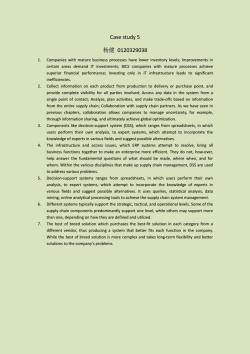上海交通大学:《供应链管理 Supply Chain Management》课程教学资源(讲义资料)Case Studies_SampleWork2013Spring_Wal-Mart_case study5_杨健

Case study 5 杨健0120329038 1.Companies with mature business processes have lower inventory levels;Improvements in certain areas demand IT investments;BICS companies with mature processes achieve superior financial performance;Investing only in IT infrastructure leads to significant inefficiencies. 2.Collect information on each product from production to delivery or purchase point,and provide complete visibility for all parties involved;Access any data in the system from a single point of contact;Analyze,plan activities,and make trade-offs based on information from the entire supply chain;Collaboration with supply chain partners.As we have seen in previous chapters,collaboration allows companies to manage uncertainty,for example, through information sharing,and ultimately achieve global optimization. 3.Components like decision-support system(DSS),which ranges from spreadsheets,in which users perform their own analysis,to expert systems,which attempt to incorporate the knowledge of experts in various fields and suggest possible alternatives. 4.The infrastructure and access issues,which ERP systems attempt to resolve,bring all business functions together to make an enterprise more efficient.They do not,how-ever, help answer the fundamental questions of what should be made,where when,and for whom.Within the various disciplines that make up supply chain management,DSS are used to address various problems. 5.Decision-support systems ranges from spreadsheets,in which users perform their own analysis,to expert systems,which attempt to incorporate the knowledge of experts in various fields and suggest possible alternatives.It uses queries,statistical analysis,data mining,online analytical processing tools to achieve the supply chain system management. 6.Different systems typically support the strategic,tactical,and operational levels.Some of the supply chain components predominantly support one level,while others may support more than one,depending on how they are defined and utilized. 7.The best of breed solution which purchases the best-fit solution in each category from a different vendor,thus producing a system that better fits each function in the company. While the best of breed solution is more complex and takes long-term flexibility and better solutions to the company's problems
Case study 5 杨健 0120329038 1. Companies with mature business processes have lower inventory levels; Improvements in certain areas demand IT investments; BICS companies with mature processes achieve superior financial performance; Investing only in IT infrastructure leads to significant inefficiencies. 2. Collect information on each product from production to delivery or purchase point, and provide complete visibility for all parties involved; Access any data in the system from a single point of contact; Analyze, plan activities, and make trade-offs based on information from the entire supply chain; Collaboration with supply chain partners. As we have seen in previous chapters, collaboration allows companies to manage uncertainty, for example, through information sharing, and ultimately achieve global optimization. 3. Components like decision-support system (DSS), which ranges from spreadsheets, in which users perform their own analysis, to expert systems, which attempt to incorporate the knowledge of experts in various fields and suggest possible alternatives. 4. The infrastructure and access issues, which ERP systems attempt to resolve, bring all business functions together to make an enterprise more efficient. They do not, how-ever, help answer the fundamental questions of what should be made, where when, and for whom. Within the various disciplines that make up supply chain management, DSS are used to address various problems. 5. Decision-support systems ranges from spreadsheets, in which users perform their own analysis, to expert systems, which attempt to incorporate the knowledge of experts in various fields and suggest possible alternatives. It uses queries, statistical analysis, data mining, online analytical processing tools to achieve the supply chain system management. 6. Different systems typically support the strategic, tactical, and operational levels. Some of the supply chain components predominantly support one level, while others may support more than one, depending on how they are defined and utilized. 7. The best of breed solution which purchases the best-fit solution in each category from a different vendor, thus producing a system that better fits each function in the company. While the best of breed solution is more complex and takes long-term flexibility and better solutions to the company’s problems
按次数下载不扣除下载券;
注册用户24小时内重复下载只扣除一次;
顺序:VIP每日次数-->可用次数-->下载券;
- 上海交通大学:《供应链管理 Supply Chain Management》课程教学资源(讲义资料)Case Studies_SampleWork2013Spring_Wal-Mart report_沃尔玛报告 罗岩.doc
- 上海交通大学:《供应链管理 Supply Chain Management》课程教学资源(讲义资料)Case Studies_SampleWork2013Spring_Wal-Mart report_WalMartReport陶鸿涛.docx
- 上海交通大学:《供应链管理 Supply Chain Management》课程教学资源(讲义资料)Case Studies_SampleWork2013Spring_Wal-Mart report_WalMart report_杨健.docx
- 上海交通大学:《供应链管理 Supply Chain Management》课程教学资源(讲义资料)Case Studies_SampleWork2013Spring_Wal-Mart report_Wal-Mart_金梦珂.docx
- 上海交通大学:《供应链管理 Supply Chain Management》课程教学资源(讲义资料)Case Studies_SampleWork2013Spring_RFID research plan_RFID.docx
- 上海交通大学:《供应链管理 Supply Chain Management》课程教学资源(讲义资料)Case Studies_SampleWork2013Spring_RFID research plan_RFID in parking lot research plan.docx
- 上海交通大学:《供应链管理 Supply Chain Management》课程教学资源(讲义资料)Case Studies_SampleWork2013Spring_RFID research plan_research plan.doc
- 上海交通大学:《供应链管理 Supply Chain Management》课程教学资源(讲义资料)Case Studies_SampleWork2013Spring_RFID research plan_research plan.doc
- 上海交通大学:《供应链管理 Supply Chain Management》课程教学资源(讲义资料)Case Studies_SampleWork2013Spring_RFID report_RFID report_金梦珂.docx
- 上海交通大学:《供应链管理 Supply Chain Management》课程教学资源(讲义资料)Case Studies_SampleWork2013Spring_RFID report_RFID report_杨健.docx
- 上海交通大学:《供应链管理 Supply Chain Management》课程教学资源(讲义资料)Case Studies_SampleWork2013Spring_RFID report_RFID Ensure Patients' Security-罗岩.doc
- 上海交通大学:《供应链管理 Supply Chain Management》课程教学资源(讲义资料)Case Studies_SampleWork2013Spring_RFID report_RFID Based Library Management System陶鸿涛.doc
- 上海交通大学:《供应链管理 Supply Chain Management》课程教学资源(讲义资料)Case Studies_SampleWork2013Spring_Meditech_Meditech罗岩.doc
- 上海交通大学:《供应链管理 Supply Chain Management》课程教学资源(讲义资料)Case Studies_SampleWork2013Spring_Meditech_Meditech_金梦珂.docx
- 上海交通大学:《供应链管理 Supply Chain Management》课程教学资源(讲义资料)Case Studies_SampleWork2013Spring_Meditech_Meditech 陶鸿涛.docx
- 上海交通大学:《供应链管理 Supply Chain Management》课程教学资源(讲义资料)Case Studies_SampleWork2013Spring_Meditech_case study1杨健.docx
- 上海交通大学:《供应链管理 Supply Chain Management》课程教学资源(讲义资料)Case Studies_SampleWork2013Spring_Jam Electronics_JamElectronics陶鸿涛.doc
- 上海交通大学:《供应链管理 Supply Chain Management》课程教学资源(讲义资料)Case Studies_SampleWork2013Spring_Jam Electronics_Jam Electronics_金梦珂.docx
- 上海交通大学:《供应链管理 Supply Chain Management》课程教学资源(讲义资料)Case Studies_SampleWork2013Spring_Jam Electronics_Jam Electronics_杨健.docx
- 上海交通大学:《供应链管理 Supply Chain Management》课程教学资源(讲义资料)Case Studies_SampleWork2013Spring_Jam Electronics_Jam Electronics 罗岩.doc
- 上海交通大学:《供应链管理 Supply Chain Management》课程教学资源(讲义资料)Case Studies_SampleWork2013Spring_Wal-Mart_HWforweek12_金梦珂.docx
- 上海交通大学:《供应链管理 Supply Chain Management》课程教学资源(讲义资料)Case Studies_SampleWork2013Spring_Wal-Mart_Wal-Mart 罗岩.doc
- 上海交通大学:《供应链管理 Supply Chain Management》课程教学资源(讲义资料)Case Studies_SampleWork2013Spring_Wal-Mart_WalMartGroupDiscussion.docx
- 上海交通大学:《供应链管理 Supply Chain Management》课程教学资源(讲义资料)Experiments_Sample Reports_Beer Game_beer game 罗岩.doc
- 上海交通大学:《供应链管理 Supply Chain Management》课程教学资源(讲义资料)Experiments_Sample Reports_Beer Game_Beer Game-金梦珂.docx
- 上海交通大学:《供应链管理 Supply Chain Management》课程教学资源(讲义资料)Experiments_Sample Reports_Beer Game_BeerGameReport_杨健.docx
- 上海交通大学:《供应链管理 Supply Chain Management》课程教学资源(讲义资料)Experiments_Sample Reports_Beer Game_BeerGameReport陶鸿涛.doc
- 上海交通大学:《供应链管理 Supply Chain Management》课程教学资源(讲义资料)Experiments_Sample Reports_Beer Game_beerGame_Report(贺艺).docx
- 上海交通大学:《供应链管理 Supply Chain Management》课程教学资源(讲义资料)Experiments_Sample Reports_Risk Pooling_Risk Pooling 罗岩.doc
- 上海交通大学:《供应链管理 Supply Chain Management》课程教学资源(讲义资料)Experiments_Sample Reports_Risk Pooling_RiskPoolExperimentReport.docx
- 上海交通大学:《供应链管理 Supply Chain Management》课程教学资源(讲义资料)Experiments_Sample Reports_Risk Pooling_riskpooling_金梦珂.docx
- 上海交通大学:《供应链管理 Supply Chain Management》课程教学资源(讲义资料)Group Work_GroupPresentationPPT_RFID & BARCODE.pptx
- 上海交通大学:《供应链管理 Supply Chain Management》课程教学资源(讲义资料)Group Work_GroupPresentationPPT_The application of RFID in cool chain.pptx
- 上海交通大学:《供应链管理 Supply Chain Management》课程教学资源(讲义资料)Group Work_Research Reports_RFID and Ticketing-Group Research.doc
- 上海交通大学:《供应链管理 Supply Chain Management》课程教学资源(讲义资料)Group Work_Research Reports_The application of RFID in cool chain.pdf
- 上海交通大学:《供应链管理 Supply Chain Management》课程教学资源(讲义资料)Group Work_合作学习指导手册.pdf
- 上海交通大学:《供应链管理 Supply Chain Management》课程教学资源(讲义资料)LectureNote(PostG)00-Introduction to Course(2012).pdf
- 上海交通大学:《供应链管理 Supply Chain Management》课程教学资源(讲义资料)LectureNote(PostG)01-Introduction to Supply Chain Management(2012).pdf
- 上海交通大学:《供应链管理 Supply Chain Management》课程教学资源(讲义资料)LectureNote(PostG)02-Inventory Management(1)(2012).pdf
- 上海交通大学:《供应链管理 Supply Chain Management》课程教学资源(讲义资料)LectureNote(PostG)02-Inventory Management(2)(2012).pdf
